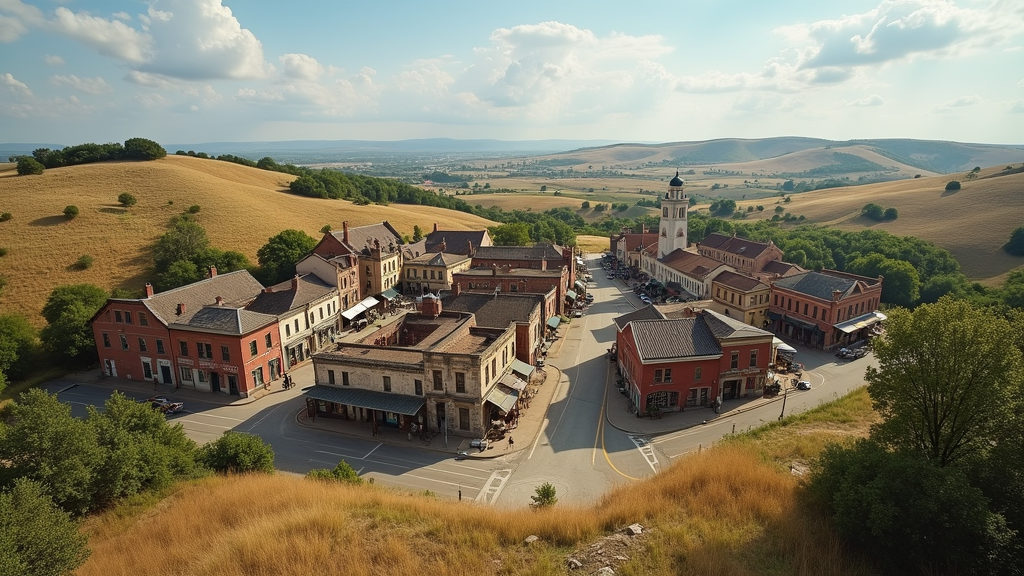Branson is a town with an exciting past that has evolved over decades to become a popular destination for music lovers and families alike. The story of Branson is one of growth, resilience, and innovation. This article takes you through its beginnings, key milestones, challenges, and modern-day advancements that have defined its ride through time.

The Early Beginnings: The Foundation of Branson
The roots of Branson extend back to a time when small towns were shaped by the pursuit of new opportunities. Early settlers arrived looking for fertile land, and the region quickly turned into a community built on hard work and ambition. In the heart of the Ozarks, the natural beauty and remoteness provided a backdrop to a story of community spirit and determination.
During its early days, Branson was characterized by modest farms, local commerce, and a sense of close-knit community values. Residents played a central role in establishing schools, small businesses, and community events that have become part of its rich historical tapestry. This period laid the groundwork for a town that would later be renowned for its blend of small-town charm and vibrant cultural offerings.
Building a Community and a Culture
In its formative years, Branson saw a next stage that was less about fast-paced change and more about nurturing community connections. Local gatherings, church events, and school plays created networks that tied residents together. The shared experiences of these early days became cornerstones of a unique cultural identity.
The local culture is built on traditions passed down through generations. Residents were quick to celebrate local music, storytelling, and craft fairs. These events not only entertained but also educated, preserving the collective memory of the town. Over time, Branson’s reputation for warm hospitality was cemented by its emphasis on community over competition. This environmental nurturing is one element that continues to shape Branson’s present-day charm.
Key Milestones in Branson’s Next Stage
The progression of Branson’s history is marked by several key milestones that each contributed to the town’s character. As transportation improved in the early 20th century, Branson experienced a steady influx of visitors stumbling upon its scenic beauty.
During this period, notable accomplishments included the introduction of local theater shows and music clubs that reflected the spirit of the era. As the town became better connected with the rest of the country, it experienced a subtle tourism boom. Early pioneers began promoting local attractions, and soon Branson found itself on the map as a destination for weekend getaways. Its quaint streets and friendly locals drew in curious travelers.
- Birth of Local Entertainment: Community theaters and music clubs emerged as a response to local talent yearning to share their art. These initiatives became a foundational part of Branson’s cultural fabric.
- Transportation Advances: Improvements in road networks and the expansion of rail lines allowed more people to visit. This change turned Branson into a stop for travelers from neighboring regions.
- Economic Diversification: Small businesses began to flourish—from local diners to artisan shops—paving the way for Branson’s later reputation as a hub of cultural and economic activity.
These milestones not only set the stage for Branson’s transformation but also symbolized the town’s openness to change and innovation. Each achievement built on the previous one, slowly transforming the community into a destination known for its unique character and enduring appeal.
Challenges and Turning Points Over the Years
No ride through history is without its challenges, and Branson’s transformation is no exception. Over time, the town encountered several hurdles that tested the resilience of its community.
Economic downturns and shifts in regional industry posed significant challenges. As local industries fluctuated with broader economic trends, Branson had to adapt and reinvent its identity. Adverse weather, natural events, and changing demographics further contributed to tough times in its early years.
During periods of uncertainty, community leadership and collective action played a vital role. People came together to support one another through difficult phases. Civic leaders initiated programs to revitalize local businesses and attract investors, helping the town navigate through downward cycles.
Cultural Transitions
As new forms of media emerged and societal interests switched up, there was a strong push to maintain the town’s cultural integrity even as it modernized. Efforts to blend traditional values with contemporary influences became a turning point in preserving Branson’s uniqueness.
Next Stage in Technology
The arrival of new technologies also introduced challenges. Modern communication and transportation eventually replaced many traditional methods of business and socializing. Branson’s residents learned to adapt, eventually turning these challenges into opportunities by integrating newer technology with the town’s rich history and traditions.
These hurdles were not signs of defeat but rather important chapters in a story of adaptation and survival. Each challenge ultimately contributed to the resilience and creative spirit that defines Branson today.
Modern Branson: Entertainment and Economic Growth
The face of Branson has changed dramatically over the decades. Once an industrious farming community, it now stands as a vibrant center for entertainment and tourism. Historic theaters and local festivals now take the spotlight, drawing visitors from across the country.
Today, Branson is recognized for its diverse range of live shows, amusement parks, and family-friendly attractions. This modern identity did not emerge overnight but was built step by step, influenced by the lessons learned from its past. The transformation from a small town to a popular destination required embracing both the traditional charm and the benefits of economic innovation.
The ride has involved significant investments in infrastructure and the arts. Modern Branson takes advantage of its historical background as a foundation for new growth. For example, many local business owners have maintained vintage architecture while introducing modern amenities, merging the old with the new seamlessly. This blend has created an environment that honors tradition while promising a bright future.
Cultural and Economic Impact of Branson’s Next Stage
Branson’s history has left a lasting imprint on both its cultural and economic landscape. Its transformation has influenced local arts, shops, and dining experiences. The town’s change has also enriched the local economy by attracting a steady stream of tourists and investors.
The cultural impact of Branson’s transformation is evident in the celebration of its heritage through festivals, art displays, and local performances. Town events serve as public exhibitions of both historical artifacts and contemporary creativity. These celebrations help maintain a community identity that values its historical roots while also embracing modern trends.
Economically, this transformation has brought varied opportunities. The influx of tourists has spurred demand in sectors such as hospitality, retail, and entertainment. Local enterprises have flourished by adapting to shifting market trends, demonstrating how history can positively influence current economic practices. The continuity between past and present is celebrated in museums and public spaces that showcase Branson’s rich legacy.
This interplay of culture and economy not only benefits residents but also encourages future generations to appreciate and build upon the town’s historical foundation. It is a living example of how a community can honor its past while paving the way for future successes.
Looking Ahead: The Future of Branson
The future of Branson looks bright as the town embraces both its storied past and emerging opportunities. There is a strong drive to step up local infrastructure while preserving the historical essence that makes the town unique. Continued investments in the arts, tourism, and community development promise further economic growth, ensuring that Branson’s legacy continues to thrive.
Modern planners and community members alike are focused on sustainable development. Efforts to protect green spaces, modernize facilities while preserving historic sites, and nurture local arts contribute to a future that respects tradition without sacrificing progress. Upcoming projects include improved cultural venues, upgraded public facilities, and initiatives aimed at celebrating the town’s history through interactive exhibitions and festivals.
Branson’s ride is one of ongoing transformation. As challenges are met with determination and community spirit, the town is poised to write the next chapters of its unique history. The balance between celebrating past milestones and embracing modern advancements creates an exciting path forward for residents and visitors alike.
Every street, every building, and every festival tells a part of Branson’s story. The lessons learned from early struggles and the innovative strides taken in recent decades combine to create a mosaic that is both rich in history and dynamic in its outlook.
This narrative not only reminds us of Branson’s humble beginnings but also celebrates its transformation into a thriving, multifaceted community. By continuing to honor its traditions and welcoming fresh ideas, Branson sets itself up as a beacon of resilience and cultural richness for decades to come.
A Closer Look at Local Art and Stories
The town’s creative heartbeat is evident in its thriving art scene and the countless personal stories shared by longtime residents. Local galleries, street murals, and bustling craft fairs provide platforms where artists mix together traditional techniques with modern twists. Many community members take pride in their family legacies and personal tales that have been passed down from one generation to another. These expressions of creativity have helped shape not only the physical landscape of Branson but also the invisible threads that connect past to present.
Each art exhibition is more than just a display—it is an opportunity to say again that Branson’s spirit is alive and well. Visitors get a chance to stroll through vibrant art districts where local painters, sculptors, and photographers display next-level cool artworks. In intimate coffee shops and community centers, storytelling sessions allow residents to share memories of old festivals, family recipes, and historic anecdotes. These gatherings are a reminder that creativity and community go hand in hand, uplifting each other as they fill the streets with energy and inspiration.
The economic benefits of this creative scene are significant as well. By drawing art lovers and cultural enthusiasts from near and far, local businesses experience a boost in patronage. Cafes, boutique stores, and performance venues all benefit from a steady stream of visitors who come not only to see the art but also to get involved and support local talent. Residents often say that the art isn’t just about ornamentation. It is about building connections, strengthening community pride, and ensuring that every brush stroke and every handcrafted item plays a role in Branson’s ongoing narrative.
The emphasis on art and local stories also encourages a broader dialogue about heritage and identity. Community-led workshops and public art projects invite newcomers and longtime locals alike to share their perspectives, ensuring that the cultural landscape continues to evolve. In doing so, Branson not only preserves its history but also creates a living, breathing canvas where every individual contributes to the picture of a community that is as diverse as it is united.
Reflections from the Locals and Environmental Insights
Every conversation with a local in Branson reveals layers of history and personal insight. Longtime residents fondly recall the days when community events were simple gatherings that brought neighbors together under starlit skies. These reflections are coupled with an awareness of how nature has played an essential role in the town’s appeal. People here take pride in the surrounding green spaces, which provide a natural retreat and a reminder of Branson’s rural origins.
Efforts to modernize have not come at the expense of the environment. Local initiatives to protect parks and conserve natural resources are very important. Community projects often involve cleaning local waterways, planting trees, and creating small gardens around historic landmarks. These environmental efforts are a testament to the town’s commitment to blending progress with preservation, ensuring that future generations will have both a rich cultural legacy and a healthy natural environment to enjoy.
In sharing these stories, Branson’s residents continue to send a clear message: that history, art, culture, and nature are threads woven together into the fabric of everyday life here. Their voices give life to the town’s narrative, encouraging everyone—locals and newcomers alike—to get involved and appreciate the multi-layered heritage of Branson.
